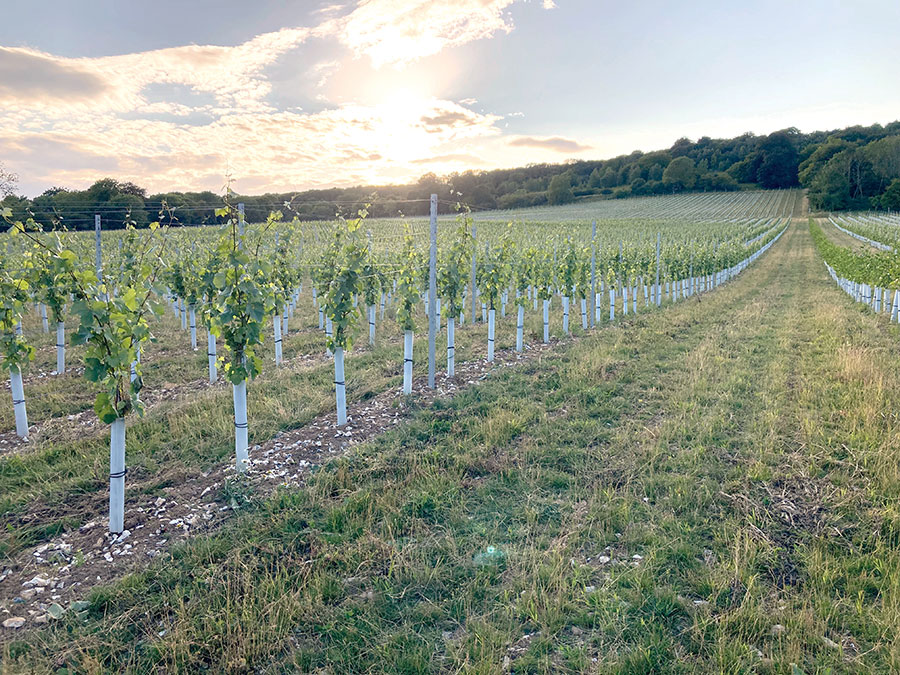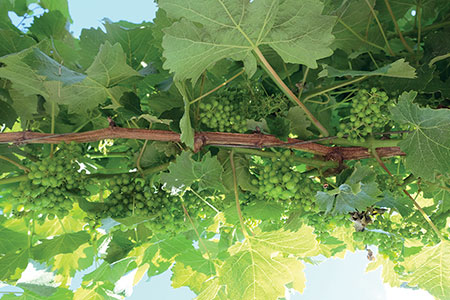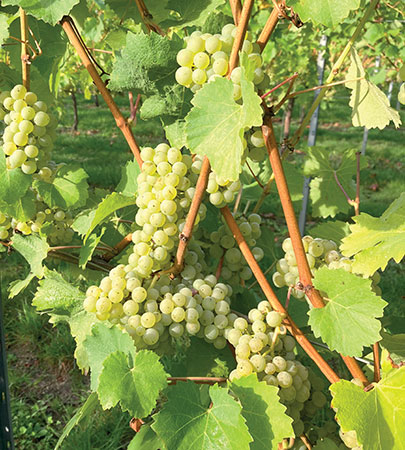Foliar options for healthy, productive vines
18th June 2024
Foliar applications are an effective way of topping up vine nutrient requirements in-season, and for applying other inputs such as biostimulants or natural plant protection products. Fruit & Vine explores some of the options this summer.

Maintaining healthy canopies with the photosynthetic capacity to supply developing bunches with everything they need is crucial to maximising yield and quality; skimping on the canopy now risks undoing all the hard work gone before.
Yes, the weather has a big influence on harvest prospects; but as that is beyond growers’ control, our focus must be on aspects we have some influence over, and foliar applications are a fast and effective way of delivering key inputs directly into the vine when required.
Foliar fertilisers offer predictable, efficient, plant uptake, and may be particularly useful for keeping vines going when soils are very dry, or on newly planted sites where roots are yet to establish, although growers cannot rely on foliar fertilisers alone for building large amounts of extension growth.
Identify requirements
Nutrition – however it is applied – should always be tailored to individual crop requirements, and many growers base in-season applications on the results of petiole or leaf analysis, usually done at flowering. Knowledge of site history and soil status is also useful.
Leaf sampling carried out slightly later, through June into July, can still provide useful information though, so may be worthwhile if not done already, says Hutchinsons agronomist, Rob Saunders. “Relative to the value of the crop, leaf analysis is a small investment that can have significant benefits.”
Focus testing on areas of the vineyard that have previously underperformed; those where potential deficiencies have been seen; or where vines are relatively recently established and may not yet have well-developed roots, he explains. Sites carrying big crops are another to prioritise.
“Occasionally, leaf analysis may not show obvious issues, despite crops not performing as expected, so in such cases, delve deeper, looking at other physical soil conditions and biology.”
Feeding canopies
Magnesium, iron and nitrogen are key nutrient deficiencies that can inhibit chlorophyll formation, and low levels of the first two commonly show on tissue testing. Nitrogen deficiency is not usually an issue on deeper, richer soils in wetter regions, however it can be a problem in some areas, especially thinner soils in the drier south east, says Rob.
For magnesium, there are two main treatment options – the most popular being magnesium sulphate, which is low cost and proven to work well. Another option, where growers require additional nitrogen, as well as magnesium, is magnesium nitrate, which offers a more plant-available nutrient form than sulphate, he advises.

“Urea is another effective nitrogen source, while a more plant-available option would be products based on amino acid feeds, such as Bridgeway or Megafol, which can be particularly useful during stress periods, or when there is a large energy demand on vines.”
Rob points out care is needed when applying any nitrogen to vines, as excessive levels fuel canopy growth, particularly where it is applied in readily-available foliar forms. Non-nitrate based feeds can help ‘toughen’ cell walls within leaves, without delivering the nitrogen element responsible for generating excess sappy growth, therefore reducing the risk of mildew or botrytis, he adds.
For iron, EDTA chelate forms are cheapest, but Rob says they are generally not as plant-available or effective as iron metalosate, which supplies amino acid chelated minerals in a ‘softer’ form that can be used immediately by plants.
“Note that for ground applications, EDDHA iron chelates are used, as these are resistant to becoming locked up by the soil chemistry and remain available to the plant.”
Feeding grape quality
From veraison onwards, Rob says the nutrition focus generally switches from feeding the canopy, to bolstering grape quality.
“Two nutrients are pivotal in this respect; potassium supports strong fruit fill and Brix accumulation, while yeast-available nitrogen affects fermentation and the wine’s flavour profile. A high potassium:nitrogen ratio also helps reduce botrytis risk.”
Potassium can be applied in various forms, including non-chlorinated pure foliar products, such as PureTech Potassium, or as potassium sulphate. For those wanting extra nitrogen, potassium nitrate is another option. Metalosate potassium is also available, although experience is limited.
Other beneficial foliar nutrients include:
Calcium: Key to building resilient cell wall structures, helping to protect vines against botrytis infection. Balanced calcium feeds containing magnesium and nitrogen can also protect against bunch stem necrosis
Magnesium: Can help reduce bunch stem necrosis
Boron: Often not held well in certain soil types. Boron is important to improve berry shape, size and sugars. It plays a role in botrytis protection too
Zinc and iron: Both can improve grape quality
Manganese: Helps prevent chlorosis in foliage and affects alcohol and sugar levels in berries. Following the loss of mancozeb (which contains manganese), Terramap soil analysis and tissue testing is highlighting more cases of sub-optimal manganese.
Building healthy vines
Targeted foliar nutritional products can help bolster plant health and natural disease resistance, Rob continues. Cultigrow (CBL), for example, is based on flavonoids, and in AHDB trials and empirical observations, it appears to reduce powdery mildew incidence due to improved plant health.

Similarly, other products, such as Procrop ISR, can stimulate the plant’s natural defence mechanisms to resist downy mildew, for which fungicide options are limited, and the disease is challenging to control through cultural techniques alone.
Such options are purely a defensive strategy though, so Rob says programmes should ideally start early in the season once there is sufficient green leaf area for uptake, and while disease risk is low, with no visible signs of infection.
“Once disease risk increases, it can be worth applying a good quality phosphite (e.g. Phorce) to further improve the robustness of plants to resist infection. Phosphites have been shown to stimulate production of antimicrobial compounds (phytoalexins), thereby enhancing the vine’s natural disease defence mechanism.
“Equally, calcium is known to help reduce botrytis risk due to its role in building stronger cell walls.”
More growers are taking the plant health concept further by incorporating biofungicides or elicitors, such as Romeo, Fytosave or Prestop, into programmes, to boost natural defences and support, or even supplement conventional chemistry.
Biostimulation
Nutrient utilisation and fruit set can also be enhanced with timely biostimulant use, and Rob says this is particularly important if trying to get secondary buds to fruit due to losses of primary buds.
The flavonoid-based treatment CropBioLife has consistently performed over several years, so is often a popular choice, he says.
Natural disease protection
Optimising nutrition is fundamental to building healthy, productive vines, and Rob says natural disease resilience can be further improved with elicitor products.
Elicitors are based on components that essentially mimic microbial attack (e.g. by a powdery mildew pathogen) when they are detected by receptors in the plant cells, tricking vines into activating various defence mechanisms.
“They can be a useful addition to late season disease control programmes, when traditional fungicide options can be limited by strict harvest intervals, typically 21 days to one month, but can be up to 63 days for those containing mancozeb.”
One useful elicitor option to consider is Fytosave, which uses two naturally occurring complex carbohydrates called COS (Chito-oligosaccharides) and OGA (Oligo-galacturonans). These provide a “double alarm” signal to stimulate the plant’s defence mechanisms, he explains.
COS is detected by cell membrane receptors as a “foreign” molecule from a pathogen, while OGA is detected as coming from damage to the plant’s own cell walls. The double biochemical alarm works quickly (within 30 minutes of application) and spreads systematically around the plant, activating three main responses. These include thickening of cell walls, thereby providing a physical barrier to disease, and increased production of anti-fungal toxins and oxidising chemicals toxic to attacking fungi.
Because of this action, elicitors must be used preventatively, before disease symptoms are visible, Rob advises. “They do not have a direct effect on plant pathogens, so are not something growers can turn to where curative action is required.”
The recommended approach is usually to start using elicitors earlier in the season, around pre-flowering, however natural defence processes can be initiated at any point in the growing season, providing no disease is present, he says.
“It typically takes three initial applications to fully build up the plant’s defence mechanisms with a product like Fytosave, so depending on disease pressure, it may be necessary to support the elicitor with conventional fungicide chemistry to prevent mildew coming in during this build-up period.
“Once natural protection has been established, it should be maintained with regular follow-up applications throughout the remainder of the season to harvest. Treatment intervals are typically every 7–10 days, although this varies according to the product and disease pressure.
“Always check the recommended intervals between applications and maximum number of treatments allowed on the label.”
In high disease pressure situations, Rob says elicitors will need supporting with conventional fungicides, but generally there is good tank mix compatibility.
Read more vine news
